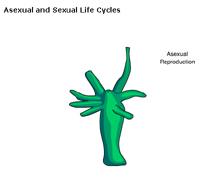
What name is given to this process?
asexual reproduction
A single individual is reproducing.
Human gametes are produced by _____.
meiosis
Meiosis produces haploid gametes from a diploid parental cell.
Normal human gametes carry _____ chromosomes.
23
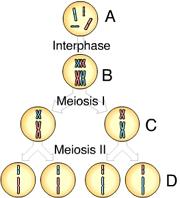
Which of these cells is (are) haploid?
C and D
Once meiosis I is completed, cells are haploid.
A diploid organism whose somatic (nonsex) cells each contain 32 chromosomes produces gametes containing _____ chromosomes.
16 (half of 32)
Asexual reproduction _____.
produces offspring genetically identical to the parent
Only one individual makes a genetic contribution to the offspring.
What number and types of chromosomes are found in a human somatic cell?
44 autosomes and 2 sex chromosomes
Human somatic cells contain 22 pairs of autosomes and either two X chromosomes (in females) or an X and a Y chromosome (in males).
Which is the smallest unit containing the entire human genome?
one human somatic cell
For what purpose(s) might a karyotype be prepared?
for prenatal screening, to determine if a fetus has the correct number of chromosomes
to determine whether a fetus is male or female
to detect the possible presence of chromosomal abnormalities such as deletions, inversions, or translocations
In alternation of generations, what is the diploid stage of a plant that follows fertilization called?
sporophyte
The sporophyte is the diploid, multicellular stage of the plant that produces haploid spores by meiosis.
How are sister chromatids and homologous chromosomes different from each other?
Homologous chromosomes contain the same gene loci but may have different alleles of a particular gene. Sister chromatids are identical copies of each other produced during DNA replication.
Which of the following is a true statement about sexual vs. asexual reproduction?
In sexual reproduction, individuals transmit 50% of their genes to each of their offspring.
Which of the following is true of a species that has a chromosome number of 2n = 16?
Each cell has eight homologous pairs.
Which of these statements is false?
At sexual maturity, ovaries and testes produce diploid gametes by meiosis.
Referring to a plant's sexual life cycle, which of the following terms describes the process that leads directly to the formation of gametes?
gametophyte mitosis
Which of the following is an example of alternation of generations?
A diploid plant (sporophyte) produces, by meiosis, a spore that gives rise to a multicellular, haploid pollen grain (gametophyte).
A triploid cell contains three sets of chromosomes. If a cell of a usually diploid species with 42 chromosomes per cell is triploid, this cell would be expected to have which of the following?
63 chromosomes in 21 sets of 3
Which of the following can utilize both mitosis and meiosis in the correct circumstances?
a plantlike protist
In a human karyotype, chromosomes are arranged in 23 pairs. If we choose one of these pairs, such as pair 14, which of the following do the two chromosomes of the pair have in common?
Length, centromere position, staining pattern, and traits coded for by their genes.
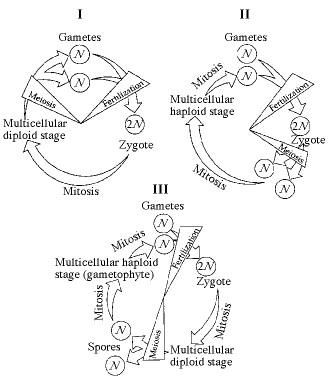
Which of the life cycles is typical for animals?
I only
Which statement correctly describes how cellular DNA content and ploidy levels change during meiosis I and meiosis II?
DNA content is halved in both meiosis I and meiosis II. Ploidy level changes from diploid to haploid in meiosis I, and remains haploid in meiosis II.
Meiosis I produces _____ cells, each of which is _____.
two ... haploid
Meiosis II typically produces _____ cells, each of which is _____.
four ... haploid
During _____ sister chromatids separate.
anaphase II
Anaphase II is essentially the same as mitotic anaphase except that the cell is haploid.
At the end of _____ and cytokinesis, haploid cells contain chromosomes that each consist of two sister chromatids.
telophase I
Synapsis occurs during _____.
prophase I
Homologous chromosomes migrate to opposite poles during _____.
anaphase I
During _____ chromosomes align single file along the equator of a haploid cell.
metaphase II
At the end of _____ and cytokinesis there are four haploid cells.
telophase II
During _____ a spindle forms in a haploid cell.
prophase II
Genetic variation occurs when chromosomes are shuffled in fertilization and what other process?
meiosis
Heritable variation is required for which of the following?
evolution
A human cell containing 22 autosomes and a Y chromosome is
a sperm.
Meiosis II is similar to mitosis in that
sister chromatids separate during anaphase.
Homologous chromosomes move toward opposite poles of a dividing cell during
meiosis I.
Which life cycle stage is found in plants but not animals?
multicellular haploid
If the DNA content of a diploid cell in the G1 phase of the cell cycle is x, then the DNA content of the same cell at metaphase of meiosis I would be
2x.
If we continued to follow the cell lineage from question 5, then the DNA content of a single cell at metaphase of meiosis II would be
x.
How many different combinations of maternal and paternal chromosomes can be packaged in gametes made by an organism with a diploid number of 8 (2n = 8)?
16
Identify all possible products of meiosis in plant and animal life cycles.
Spores
Gametes (sperm and eggs)
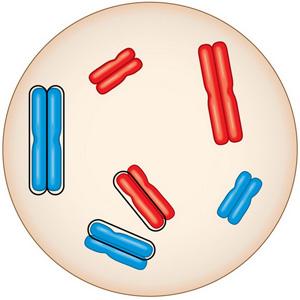
Look at the cell in the figure. Based on this figure, which of the following statements is true?
This cell is diploid.
What is the best evidence telling you whether this cell is diploid or haploid?
The cell is diploid because it contains two sets of chromosomes.
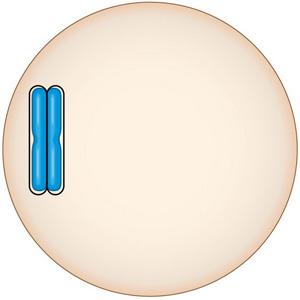
This chromosome has two chromatids, joined at the centromere. What process led to the formation of the two chromatids?
The two chromatids were formed by duplication of a chromosome.
Two sister chromatids are joined at the centromere prior to meiosis. Which statement is correct?
Barring mutation, the two sister chromatids must be identical.